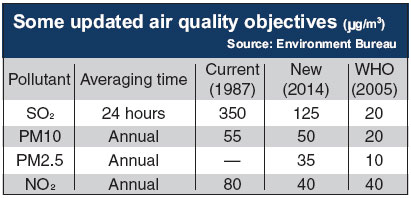Tougher pollution law promised in two years
Updated: 2012-01-18 07:22
By Kahon Chan(HK Edition)
|
|||||||

Half of new anti-pollution standards to meet strictest WHO guidelines
The government announced new air quality objectives on Tuesday, aiming to cut the city's notorious air pollution. Half of the new standards follow the strictest standards of World Health Organization (WHO), but cannot be implemented until 2014 because of necessary amendments to the law.
Though not required to do so, the Airport Authority agreed to adopt the newly proposed air quality objectives (AQOs) when assessing the environmental impact of the third runway.
Air quality objectives are established under the Air Pollution Control Ordinance. They act as mandatory benchmarks for environmental impact assessments (EIA), emission requirements for power plants and the air pollution index. The objectives currently in effect were set out in 1987, at the same time as the ordinance.
The long-awaited changes were approved on Tuesday by the Executive Council after first being proposed in a 2009 consultation document.
About half of the objectives will adopt the outdoor air quality guidelines published by WHO in 2005. Those for sulphur dioxide, particulate matter (PM10 and PM2.5) and ozone will be set according to more lenient interim targets under WHO guidelines.
Edward Yau Tang-wah, secretary for the environment, explained that most developed nations have adopted some of the interim targets and Hong Kong is facing "challenges it is unable to overcome" from its "surrounding area".
Helen Choy Shuk-yi, general manager for Clean Air Network, countered that the background pollution level has remained stable while the level of pollutants detected locally soared. "We cannot always blame others for feeding us pollutants. Pollution is just as bad when the summer winds blow our pollutants to the mainland," she said.
Apart from the 19 measures, Choy proposed the addition of stricter vehicle emission standards to help reach the new goal more effectively.
Thomas Choi Ka-man from the Friends of Earth argued the proposed benchmark for PM2.5 is too low since most areas in the city already meet that objective. He said he had also hoped for a step-by-step timeline to fully adopt the ultimate goals proposed by WHO.
As an amendment to the Air Pollution Control Ordinance was deemed necessary, the new AQOs will have be submitted for approval to the Legislative Council after 2012. Full implementation was anticipated by 2014 and the next review is to take place in 2019.
In the meantime, Yau said the "direction" is that construction projects propelled by the government before 2014 will make the best effort to adopt the new objectives even before they are mandated in law. Other projects scheduled for EIA before 2014 will not be obligated to follow the new AQOs.
EIA of the third runway, as confirmed by the Airport Authority in a statement, will adopt the new objectives alongside other statutory requirements. Improvement measures like early retirement of aged vehicles, wider use of hybrid and electric vehicles and rooftop greening were planned to offset the negative impact of the runway.
kahon@chinadailyhk.com
China Daily
(HK Edition 01/18/2012 page1)